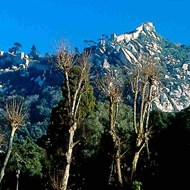Cliffs and lapiaz of Boca do Inferno (hell mouth)
Share Image
-
Cliffs and lapiaz of Boca do Inferno (hell mouth)
-
Lisboa e Vale do Tejo
-
Cascais
-
Sintra-Cascais Nature Park
Identification and Access
-
Yes
-
Access coming from:
- Cascais (± 1,5 km) – Av. da República, Av. Vigia do Facho and Av. Rei Humberto II de Itália.
- Sintra (± 19 km) – N249, N9, N9-1, Av. Infante D. Henrique, N6, Av. Vigia do Facho and Av. Rei Humberto II de Itália.
GPS: 38.6913127, -9.4328762
Base Characterization
-
Boca do Inferno (mouth of hell) results from the collapse of a cave roof, in a zone of lapiaz. In fact, between the Santa Marta lighthouse and Cresmina fort (in Guincho) is the Lapiaz of Boca do Inferno, a good place to study and observe the erosion of rocks (dolomitic limestones and dolomites) by the elements includingthe sea. From the limestones erosion the results a reddish sediment that is called terra rossa (meaning red soil) that can be observed here. In the area you can also see fossils, including some ammonites, fish teeth and oysters.
Pay attention also to layers with small rolled stones and reddish colors, because these are ancient Quaternary beaches, shows the oscillations of the level of the oceans.
At the site there is an explanatory panel about the geology and the birds that can observe there.
For security reasons don’t go near the edge, because it can be very, very dangerous, especially in stormy days. Be also very careful, because there are many holes.
Boulder – a huge rock.
Dolomite limestone - limestone with 10 to 50% of dolomite (double carbonate of calcium and magnesium). The name come from the French geologist D. Dolomieu.
Lapiaz or karren field - common landscape in limestone areas, with many grooves due to the dissolution of limestone by rainwater along fractures and cracks.
Limestone – sedimentary rock composed of calcium carbonate.
Quaternary – time period of the Cenozoic Era, beginning more or less 1.75 million years ago until today.
Terra rossa – Italian expression meaning “red soil”. The terra rossa soil is heavy and clay-rich (silty-clay to clayey) soil, strongly reddish, developed on limestone or dolomite.
-
National
Learn more
Infrastructures

Instituto da Conservação da Natureza e das Florestas, I.P.
Sintra hills Route
Lisbon and Tagus ValleyLisbon and Tagus Valley






